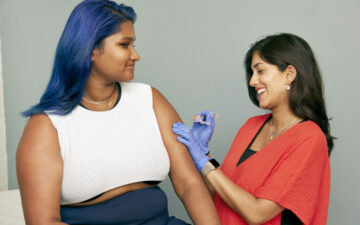NC COVID-19 case rates by school district, zip code

Paul Delamater, a health geographer and our colleague at the Carolina Population Center, is providing up-to-date estimates of COVID-19 cases and forecasts of vaccination across North Carolina. In addition to estimates, Delamater and a team of researchers are mapping:
Schools
Per zip code
Vaccination rates
We find Delamater’s maps to be really helpful and asked him a few questions about COVID-19 and North Carolina this fall.
I don’t really forecast out that far because my models simply extend what’s been happening recently out into the future. I think that they’re useful for understanding what could happen in the near future if nothing changes. For the next couple of weeks, my models show that cases are going to continue to rise, as there are still many people who remain susceptible to infection.
Right now, it looks like transmission will be higher when school starts this year than it was when school started last year. I am very concerned for elementary and middle schools, where there will be a lot of unvaccinated people sharing space. While children have had much better outcomes than adults (when infected), I am concerned that they will spread to vulnerable people in their homes and communities.
I use a compartmental model called an SEIR model, which categorizes people as Susceptible, Exposed, Infectious, and Recovered, with categories added for people who have been vaccinated and are immune (recovered). In my model, I calculate new infections, then adjust for testing volume to estimate lab-confirmed cases (which I compare to observed data from NCDHHS for validation).
I’m currently working on a metric that basically captures the risk of a massive, quick outbreak for each county based on people infected, people susceptible, and people immune.
Need help understanding population change and its impacts on your community or business? Carolina Demography offers demographic research tailored to your needs.
Contact us today for a free initial consultation.
Contact UsCategories: COVID-19, NC in Focus

The Center for Women’s Health Research (CWHR) at the University of North Carolina School of Medicine released the 12th edition of our North Carolina Women’s Health Report Card on May 9, 2022. This document is a progress report on the…

Dr. Krista Perreira is a health economist who studies disparities in health, education, and economic well-being. In collaboration with the Urban Institute, she recently co-led a study funded by the Kate B. Reynolds Foundation to study barriers to access to…

Our material helped the NC Local News Lab Fund better understand and then prioritize their funding to better serve existing and future grant recipients in North Carolina. The North Carolina Local News Lab Fund was established in 2017 to strengthen…
Your support is critical to our mission of measuring, understanding, and predicting population change and its impact. Donate to Carolina Demography today.